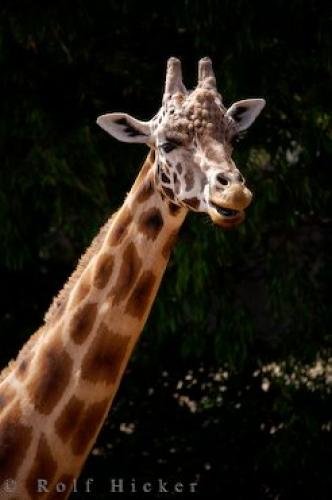Photo: Giraffe Facts
You can view a giraffe at the Auckland Zoo in New Zealand and learn all the facts of this intriguing animal.
By looking at this picture of a giraffe taken at the Auckland Zoo in New Zealand you can see that there are many fascinating facts to be learned. There are nine subspecies of the giraffe in the wild and they all reside in separate regions in Africa and each shares different color patterns. The patterns on a giraffe are all individualized just like our fingerprints and the coloring is ideal for camouflage.
Facts say that the long neck of the giraffe contains pumping ventricles in order for enough blood to reach its head and both sexes have rigid manes that run along the backs of their necks. They have two small knobs on the tops of their heads at birth which grow into horn like structures as they mature.
The giraffe is an extremely fast runner that can reach speeds of up to 35 miles per hour which is helpful when they need to outrun their enemies. They are also known for their ferocious kick that could easily kill a predator with one strike. ... continue below the picture...
Giraffe Facts

at the Auckland Zoo in New Zealand.
Pictures from photo gallery "Railway"
Related stock photo galleries, pictures & travel ideas:
Giraffe Facts
... The giraffe is the tallest land animal with some males reaching up to nineteen feet and weighing anywhere from 1,100 to 2,800 pounds.
Their long tongues aid the giraffe as he eats regularly in the day from the young leaves, shoots, twigs and bark on the tops of trees. Facts also say that a giraffe can go without water for several days but prefers to drink on a daily basis if possible.
The giraffe is a very interesting animal that loves the hot sun of its African homeland where they roam the savannahs and thorn bush.
Giraffe, Garaffa camelopardalis, in the Pridelands area of the Auckland Zoo, Auckland, North Island, New Zealand.
Technical Information:
I photographed this photo with the digital SLR camera model Canon EOS-1Ds Mark II, aperture of f/5.6, exposure time of 1/500 sec. on ISO 200, as always I used a original Canon Lens, the focus lenght for this picture was 400mm.
You can view a giraffe at the Auckland Zoo in New Zealand and learn all the facts of this intriguing animal.
